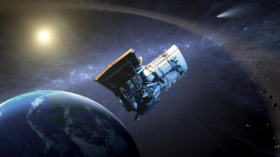Should we be worried? ‘Big Ben-sized’ asteroid to make ‘close approach’ of Earth at 30,000mph today

An asteroid named 2013 MD8, measuring almost 280ft in diameter and travelling at over 30,000mph, will just miss the Earth later today, performing one of three Near-Earth Object (NEO) flybys this week.
The Near-Earth Object will make what is considered a “close approach” at 15 times the distance between the Moon and the Earth, roughly three million miles away, at 12:55pm (ET) Tuesday, but is considered no threat.
NEOs are classified as all asteroids and comets that orbit within 30 million miles of Earth, and of this group, those that pass within a radius of 4,600,000 miles of the Earth are considered “hazardous.” 16,000 out of 600,000 known asteroids in our solar system are considered NEOs.
With a diameter of nearly 280ft, 2013 MD8 is roughly the size of Big Ben in the UK or roughly two-and-a-half times the Statue of Liberty.

“NASA knows of no asteroid or comet currently on a collision course with Earth, so the probability of a major collision is quite small. In fact, as best as we can tell, no large object is likely to strike the Earth any time in the next several hundred years,” NASA wrote previously.
Another two close flybys are expected to take place Wednesday, passing within 3.3 19.1 lunar distances, travelling at speeds of up to 29,893 and 59,244 miles per hour respectively.
Think your friends would be interested? Share this story!














